Nursing Assignment: Analysis of Healthcare Issues and Legislation
VerifiedAdded on 2022/09/15
|6
|1382
|21
Essay
AI Summary
This essay provides an overview of healthcare issues, focusing on the impact of economic, sociocultural, and environmental influences on healthcare and nursing. It highlights health disparities, which negatively affect underprivileged communities, and discusses the importance of health equity. The essay summarizes relevant legislation such as the Civil Rights Act of 1964, the Hill Burton Act of 1946, and the Americans with Disabilities Act of 1990 and 2008. It emphasizes the need for clear definitions in public policy to promote goals and evaluate progress, particularly in addressing health inequalities. Furthermore, the essay explores social disadvantage and the role of advocacy planning in raising public awareness and promoting community engagement. The bibliography includes various sources that support the discussion of these issues.
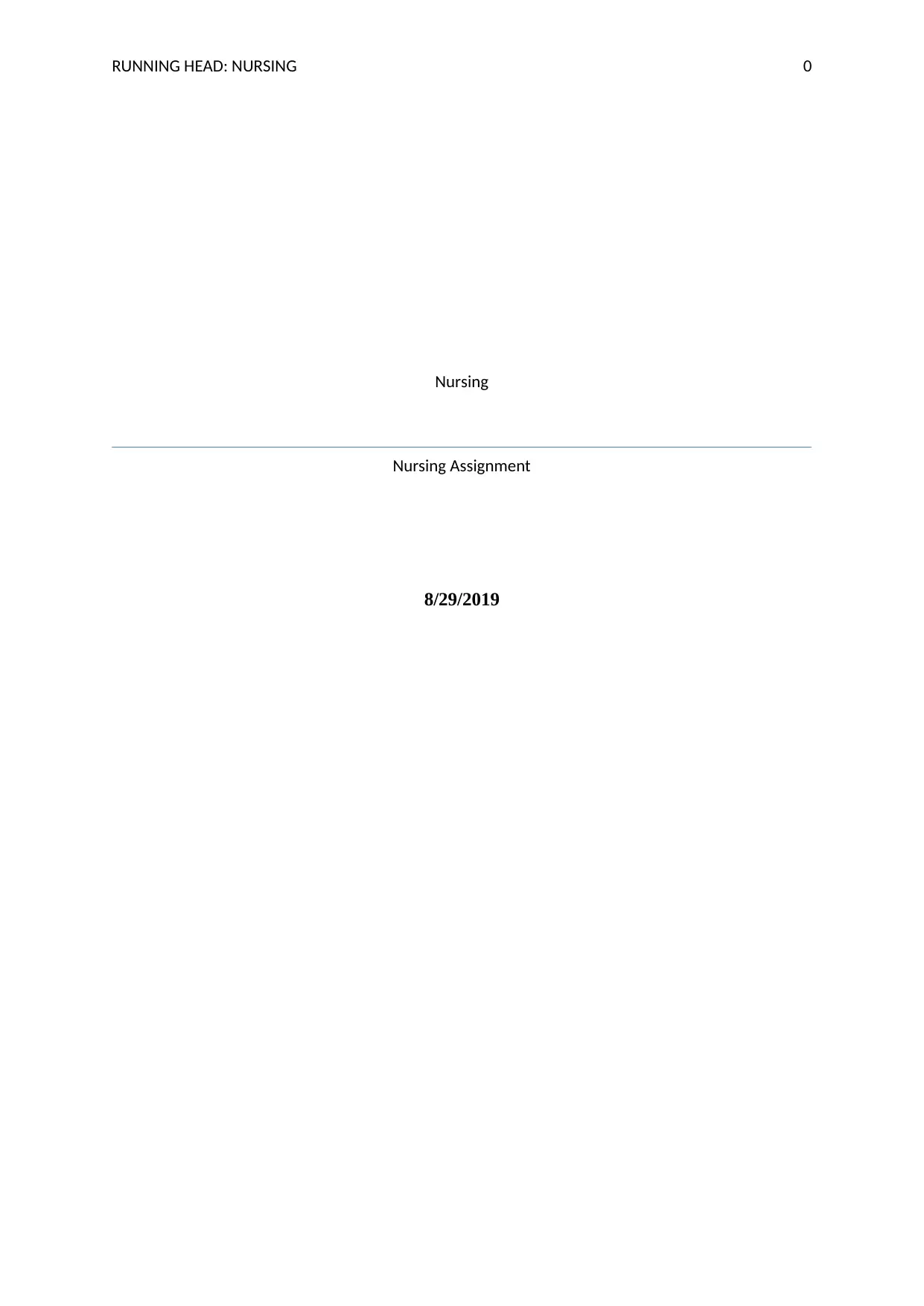
RUNNING HEAD: NURSING 0
Nursing
Nursing Assignment
8/29/2019
Nursing
Nursing Assignment
8/29/2019
Paraphrase This Document
Need a fresh take? Get an instant paraphrase of this document with our AI Paraphraser
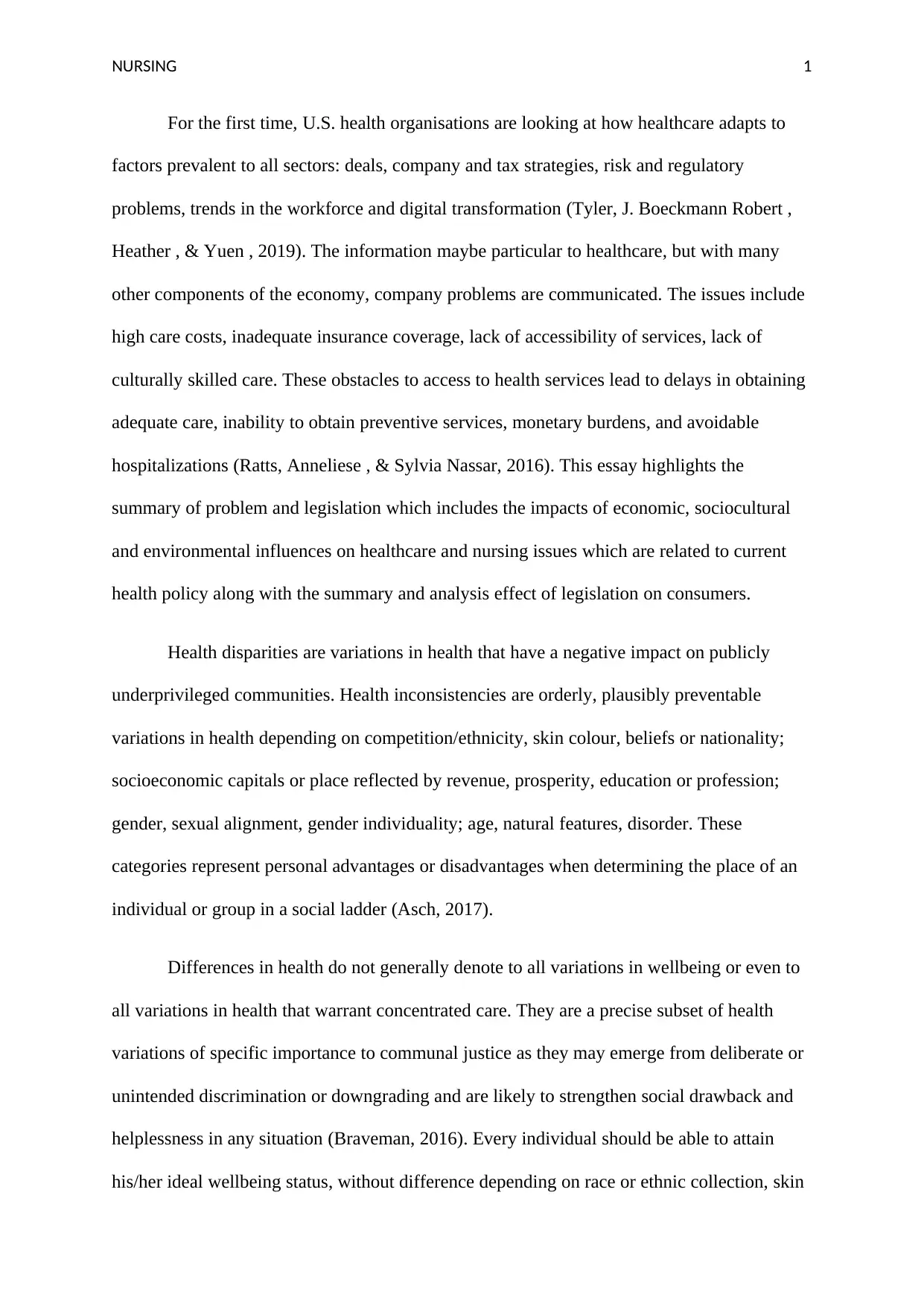
NURSING 1
For the first time, U.S. health organisations are looking at how healthcare adapts to
factors prevalent to all sectors: deals, company and tax strategies, risk and regulatory
problems, trends in the workforce and digital transformation (Tyler, J. Boeckmann Robert ,
Heather , & Yuen , 2019). The information maybe particular to healthcare, but with many
other components of the economy, company problems are communicated. The issues include
high care costs, inadequate insurance coverage, lack of accessibility of services, lack of
culturally skilled care. These obstacles to access to health services lead to delays in obtaining
adequate care, inability to obtain preventive services, monetary burdens, and avoidable
hospitalizations (Ratts, Anneliese , & Sylvia Nassar, 2016). This essay highlights the
summary of problem and legislation which includes the impacts of economic, sociocultural
and environmental influences on healthcare and nursing issues which are related to current
health policy along with the summary and analysis effect of legislation on consumers.
Health disparities are variations in health that have a negative impact on publicly
underprivileged communities. Health inconsistencies are orderly, plausibly preventable
variations in health depending on competition/ethnicity, skin colour, beliefs or nationality;
socioeconomic capitals or place reflected by revenue, prosperity, education or profession;
gender, sexual alignment, gender individuality; age, natural features, disorder. These
categories represent personal advantages or disadvantages when determining the place of an
individual or group in a social ladder (Asch, 2017).
Differences in health do not generally denote to all variations in wellbeing or even to
all variations in health that warrant concentrated care. They are a precise subset of health
variations of specific importance to communal justice as they may emerge from deliberate or
unintended discrimination or downgrading and are likely to strengthen social drawback and
helplessness in any situation (Braveman, 2016). Every individual should be able to attain
his/her ideal wellbeing status, without difference depending on race or ethnic collection, skin
For the first time, U.S. health organisations are looking at how healthcare adapts to
factors prevalent to all sectors: deals, company and tax strategies, risk and regulatory
problems, trends in the workforce and digital transformation (Tyler, J. Boeckmann Robert ,
Heather , & Yuen , 2019). The information maybe particular to healthcare, but with many
other components of the economy, company problems are communicated. The issues include
high care costs, inadequate insurance coverage, lack of accessibility of services, lack of
culturally skilled care. These obstacles to access to health services lead to delays in obtaining
adequate care, inability to obtain preventive services, monetary burdens, and avoidable
hospitalizations (Ratts, Anneliese , & Sylvia Nassar, 2016). This essay highlights the
summary of problem and legislation which includes the impacts of economic, sociocultural
and environmental influences on healthcare and nursing issues which are related to current
health policy along with the summary and analysis effect of legislation on consumers.
Health disparities are variations in health that have a negative impact on publicly
underprivileged communities. Health inconsistencies are orderly, plausibly preventable
variations in health depending on competition/ethnicity, skin colour, beliefs or nationality;
socioeconomic capitals or place reflected by revenue, prosperity, education or profession;
gender, sexual alignment, gender individuality; age, natural features, disorder. These
categories represent personal advantages or disadvantages when determining the place of an
individual or group in a social ladder (Asch, 2017).
Differences in health do not generally denote to all variations in wellbeing or even to
all variations in health that warrant concentrated care. They are a precise subset of health
variations of specific importance to communal justice as they may emerge from deliberate or
unintended discrimination or downgrading and are likely to strengthen social drawback and
helplessness in any situation (Braveman, 2016). Every individual should be able to attain
his/her ideal wellbeing status, without difference depending on race or ethnic collection, skin
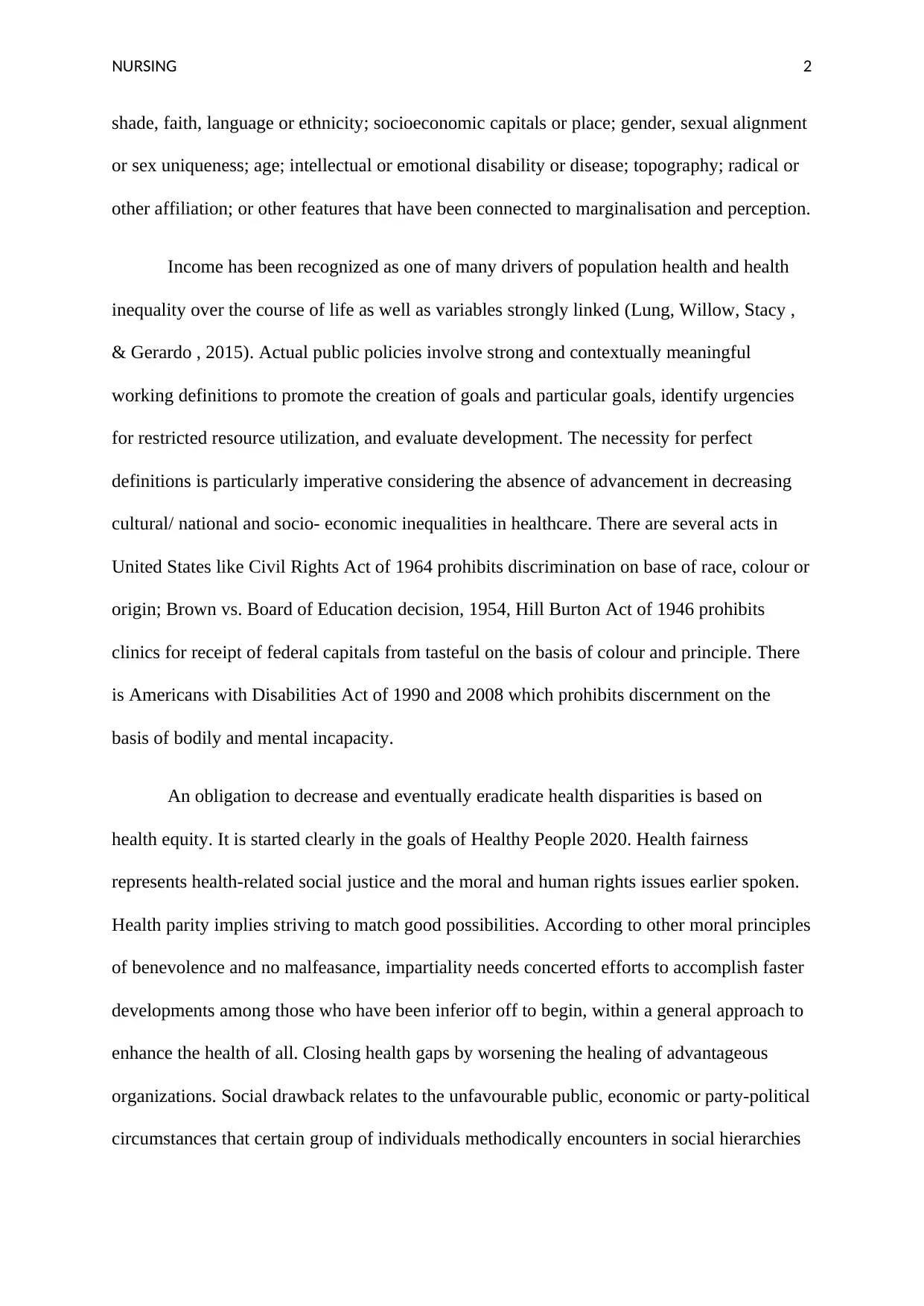
NURSING 2
shade, faith, language or ethnicity; socioeconomic capitals or place; gender, sexual alignment
or sex uniqueness; age; intellectual or emotional disability or disease; topography; radical or
other affiliation; or other features that have been connected to marginalisation and perception.
Income has been recognized as one of many drivers of population health and health
inequality over the course of life as well as variables strongly linked (Lung, Willow, Stacy ,
& Gerardo , 2015). Actual public policies involve strong and contextually meaningful
working definitions to promote the creation of goals and particular goals, identify urgencies
for restricted resource utilization, and evaluate development. The necessity for perfect
definitions is particularly imperative considering the absence of advancement in decreasing
cultural/ national and socio- economic inequalities in healthcare. There are several acts in
United States like Civil Rights Act of 1964 prohibits discrimination on base of race, colour or
origin; Brown vs. Board of Education decision, 1954, Hill Burton Act of 1946 prohibits
clinics for receipt of federal capitals from tasteful on the basis of colour and principle. There
is Americans with Disabilities Act of 1990 and 2008 which prohibits discernment on the
basis of bodily and mental incapacity.
An obligation to decrease and eventually eradicate health disparities is based on
health equity. It is started clearly in the goals of Healthy People 2020. Health fairness
represents health-related social justice and the moral and human rights issues earlier spoken.
Health parity implies striving to match good possibilities. According to other moral principles
of benevolence and no malfeasance, impartiality needs concerted efforts to accomplish faster
developments among those who have been inferior off to begin, within a general approach to
enhance the health of all. Closing health gaps by worsening the healing of advantageous
organizations. Social drawback relates to the unfavourable public, economic or party-political
circumstances that certain group of individuals methodically encounters in social hierarchies
shade, faith, language or ethnicity; socioeconomic capitals or place; gender, sexual alignment
or sex uniqueness; age; intellectual or emotional disability or disease; topography; radical or
other affiliation; or other features that have been connected to marginalisation and perception.
Income has been recognized as one of many drivers of population health and health
inequality over the course of life as well as variables strongly linked (Lung, Willow, Stacy ,
& Gerardo , 2015). Actual public policies involve strong and contextually meaningful
working definitions to promote the creation of goals and particular goals, identify urgencies
for restricted resource utilization, and evaluate development. The necessity for perfect
definitions is particularly imperative considering the absence of advancement in decreasing
cultural/ national and socio- economic inequalities in healthcare. There are several acts in
United States like Civil Rights Act of 1964 prohibits discrimination on base of race, colour or
origin; Brown vs. Board of Education decision, 1954, Hill Burton Act of 1946 prohibits
clinics for receipt of federal capitals from tasteful on the basis of colour and principle. There
is Americans with Disabilities Act of 1990 and 2008 which prohibits discernment on the
basis of bodily and mental incapacity.
An obligation to decrease and eventually eradicate health disparities is based on
health equity. It is started clearly in the goals of Healthy People 2020. Health fairness
represents health-related social justice and the moral and human rights issues earlier spoken.
Health parity implies striving to match good possibilities. According to other moral principles
of benevolence and no malfeasance, impartiality needs concerted efforts to accomplish faster
developments among those who have been inferior off to begin, within a general approach to
enhance the health of all. Closing health gaps by worsening the healing of advantageous
organizations. Social drawback relates to the unfavourable public, economic or party-political
circumstances that certain group of individuals methodically encounters in social hierarchies
⊘ This is a preview!⊘
Do you want full access?
Subscribe today to unlock all pages.

Trusted by 1+ million students worldwide
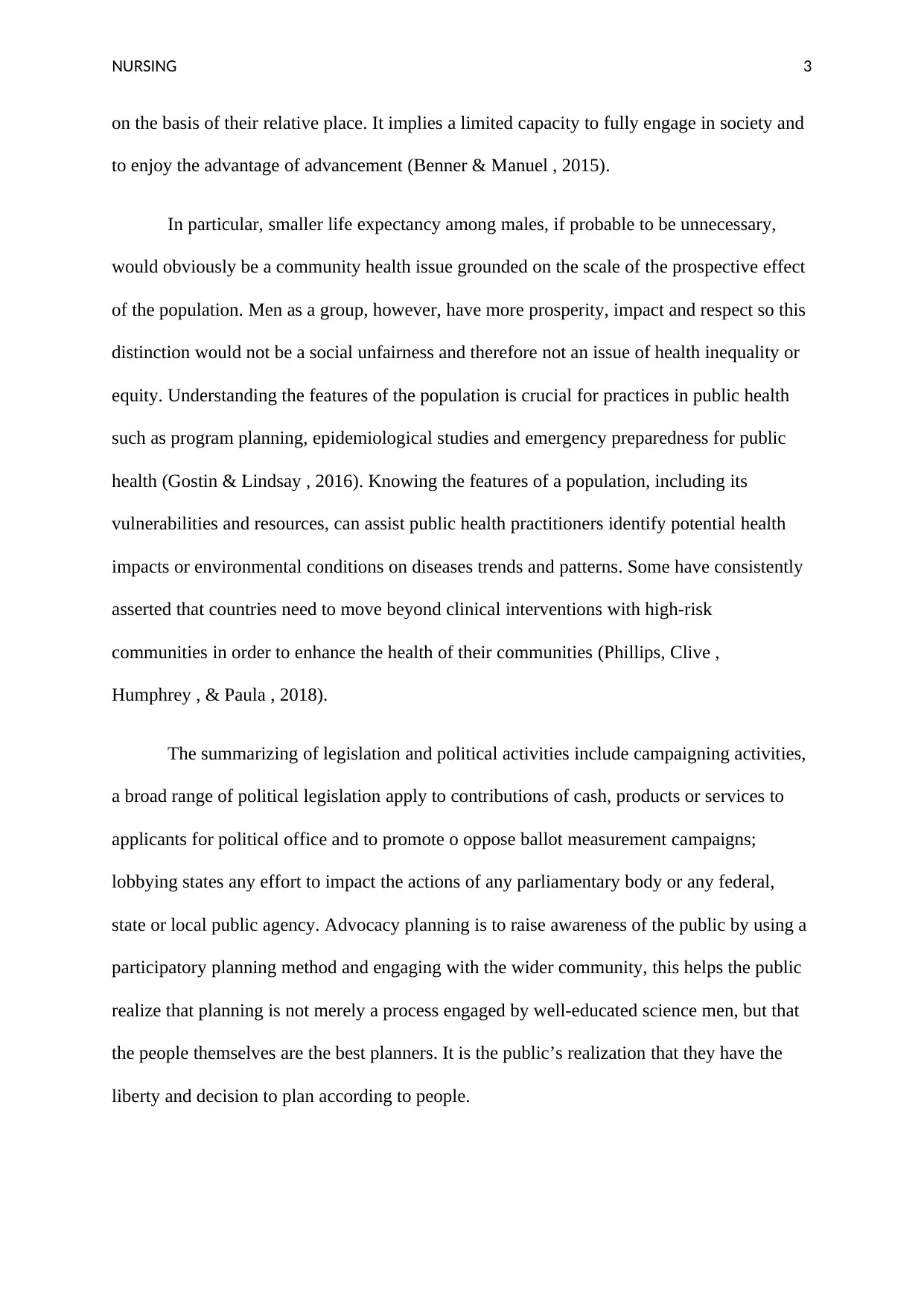
NURSING 3
on the basis of their relative place. It implies a limited capacity to fully engage in society and
to enjoy the advantage of advancement (Benner & Manuel , 2015).
In particular, smaller life expectancy among males, if probable to be unnecessary,
would obviously be a community health issue grounded on the scale of the prospective effect
of the population. Men as a group, however, have more prosperity, impact and respect so this
distinction would not be a social unfairness and therefore not an issue of health inequality or
equity. Understanding the features of the population is crucial for practices in public health
such as program planning, epidemiological studies and emergency preparedness for public
health (Gostin & Lindsay , 2016). Knowing the features of a population, including its
vulnerabilities and resources, can assist public health practitioners identify potential health
impacts or environmental conditions on diseases trends and patterns. Some have consistently
asserted that countries need to move beyond clinical interventions with high-risk
communities in order to enhance the health of their communities (Phillips, Clive ,
Humphrey , & Paula , 2018).
The summarizing of legislation and political activities include campaigning activities,
a broad range of political legislation apply to contributions of cash, products or services to
applicants for political office and to promote o oppose ballot measurement campaigns;
lobbying states any effort to impact the actions of any parliamentary body or any federal,
state or local public agency. Advocacy planning is to raise awareness of the public by using a
participatory planning method and engaging with the wider community, this helps the public
realize that planning is not merely a process engaged by well-educated science men, but that
the people themselves are the best planners. It is the public’s realization that they have the
liberty and decision to plan according to people.
on the basis of their relative place. It implies a limited capacity to fully engage in society and
to enjoy the advantage of advancement (Benner & Manuel , 2015).
In particular, smaller life expectancy among males, if probable to be unnecessary,
would obviously be a community health issue grounded on the scale of the prospective effect
of the population. Men as a group, however, have more prosperity, impact and respect so this
distinction would not be a social unfairness and therefore not an issue of health inequality or
equity. Understanding the features of the population is crucial for practices in public health
such as program planning, epidemiological studies and emergency preparedness for public
health (Gostin & Lindsay , 2016). Knowing the features of a population, including its
vulnerabilities and resources, can assist public health practitioners identify potential health
impacts or environmental conditions on diseases trends and patterns. Some have consistently
asserted that countries need to move beyond clinical interventions with high-risk
communities in order to enhance the health of their communities (Phillips, Clive ,
Humphrey , & Paula , 2018).
The summarizing of legislation and political activities include campaigning activities,
a broad range of political legislation apply to contributions of cash, products or services to
applicants for political office and to promote o oppose ballot measurement campaigns;
lobbying states any effort to impact the actions of any parliamentary body or any federal,
state or local public agency. Advocacy planning is to raise awareness of the public by using a
participatory planning method and engaging with the wider community, this helps the public
realize that planning is not merely a process engaged by well-educated science men, but that
the people themselves are the best planners. It is the public’s realization that they have the
liberty and decision to plan according to people.
Paraphrase This Document
Need a fresh take? Get an instant paraphrase of this document with our AI Paraphraser
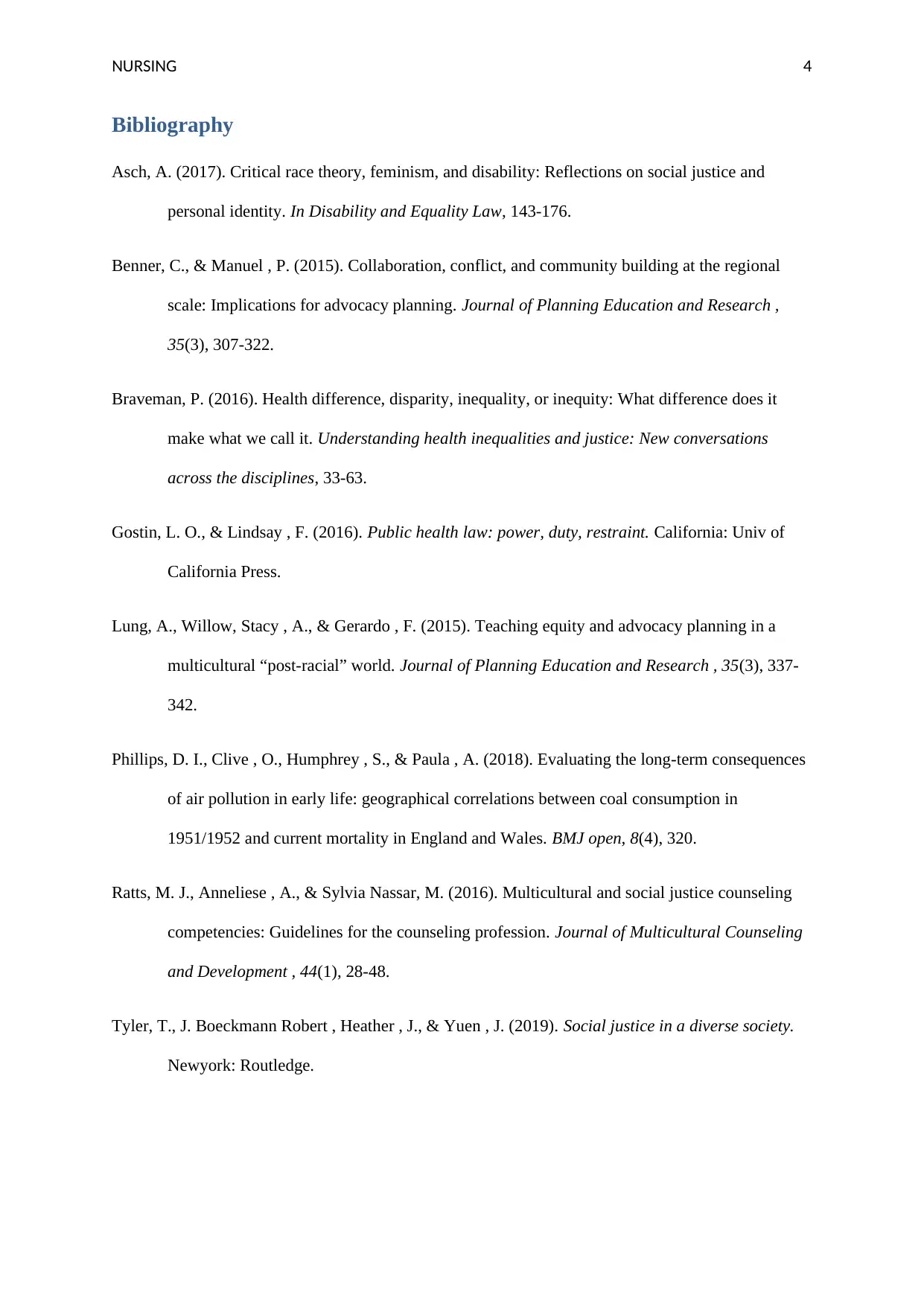
NURSING 4
Bibliography
Asch, A. (2017). Critical race theory, feminism, and disability: Reflections on social justice and
personal identity. In Disability and Equality Law, 143-176.
Benner, C., & Manuel , P. (2015). Collaboration, conflict, and community building at the regional
scale: Implications for advocacy planning. Journal of Planning Education and Research ,
35(3), 307-322.
Braveman, P. (2016). Health difference, disparity, inequality, or inequity: What difference does it
make what we call it. Understanding health inequalities and justice: New conversations
across the disciplines, 33-63.
Gostin, L. O., & Lindsay , F. (2016). Public health law: power, duty, restraint. California: Univ of
California Press.
Lung, A., Willow, Stacy , A., & Gerardo , F. (2015). Teaching equity and advocacy planning in a
multicultural “post-racial” world. Journal of Planning Education and Research , 35(3), 337-
342.
Phillips, D. I., Clive , O., Humphrey , S., & Paula , A. (2018). Evaluating the long-term consequences
of air pollution in early life: geographical correlations between coal consumption in
1951/1952 and current mortality in England and Wales. BMJ open, 8(4), 320.
Ratts, M. J., Anneliese , A., & Sylvia Nassar, M. (2016). Multicultural and social justice counseling
competencies: Guidelines for the counseling profession. Journal of Multicultural Counseling
and Development , 44(1), 28-48.
Tyler, T., J. Boeckmann Robert , Heather , J., & Yuen , J. (2019). Social justice in a diverse society.
Newyork: Routledge.
Bibliography
Asch, A. (2017). Critical race theory, feminism, and disability: Reflections on social justice and
personal identity. In Disability and Equality Law, 143-176.
Benner, C., & Manuel , P. (2015). Collaboration, conflict, and community building at the regional
scale: Implications for advocacy planning. Journal of Planning Education and Research ,
35(3), 307-322.
Braveman, P. (2016). Health difference, disparity, inequality, or inequity: What difference does it
make what we call it. Understanding health inequalities and justice: New conversations
across the disciplines, 33-63.
Gostin, L. O., & Lindsay , F. (2016). Public health law: power, duty, restraint. California: Univ of
California Press.
Lung, A., Willow, Stacy , A., & Gerardo , F. (2015). Teaching equity and advocacy planning in a
multicultural “post-racial” world. Journal of Planning Education and Research , 35(3), 337-
342.
Phillips, D. I., Clive , O., Humphrey , S., & Paula , A. (2018). Evaluating the long-term consequences
of air pollution in early life: geographical correlations between coal consumption in
1951/1952 and current mortality in England and Wales. BMJ open, 8(4), 320.
Ratts, M. J., Anneliese , A., & Sylvia Nassar, M. (2016). Multicultural and social justice counseling
competencies: Guidelines for the counseling profession. Journal of Multicultural Counseling
and Development , 44(1), 28-48.
Tyler, T., J. Boeckmann Robert , Heather , J., & Yuen , J. (2019). Social justice in a diverse society.
Newyork: Routledge.

NURSING 5
⊘ This is a preview!⊘
Do you want full access?
Subscribe today to unlock all pages.

Trusted by 1+ million students worldwide
1 out of 6
Related Documents
Your All-in-One AI-Powered Toolkit for Academic Success.
+13062052269
info@desklib.com
Available 24*7 on WhatsApp / Email
![[object Object]](/_next/static/media/star-bottom.7253800d.svg)
Unlock your academic potential
Copyright © 2020–2025 A2Z Services. All Rights Reserved. Developed and managed by ZUCOL.


